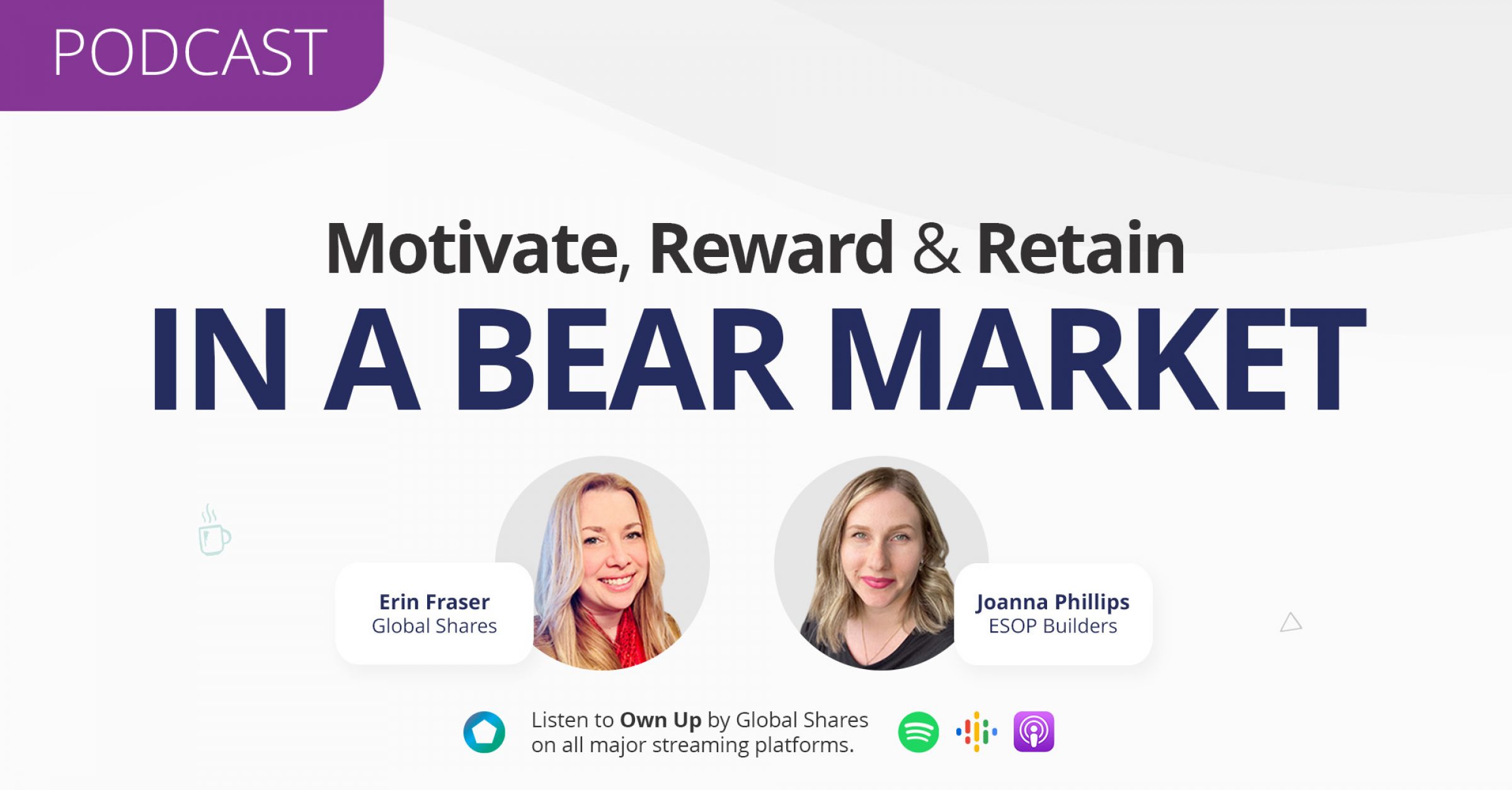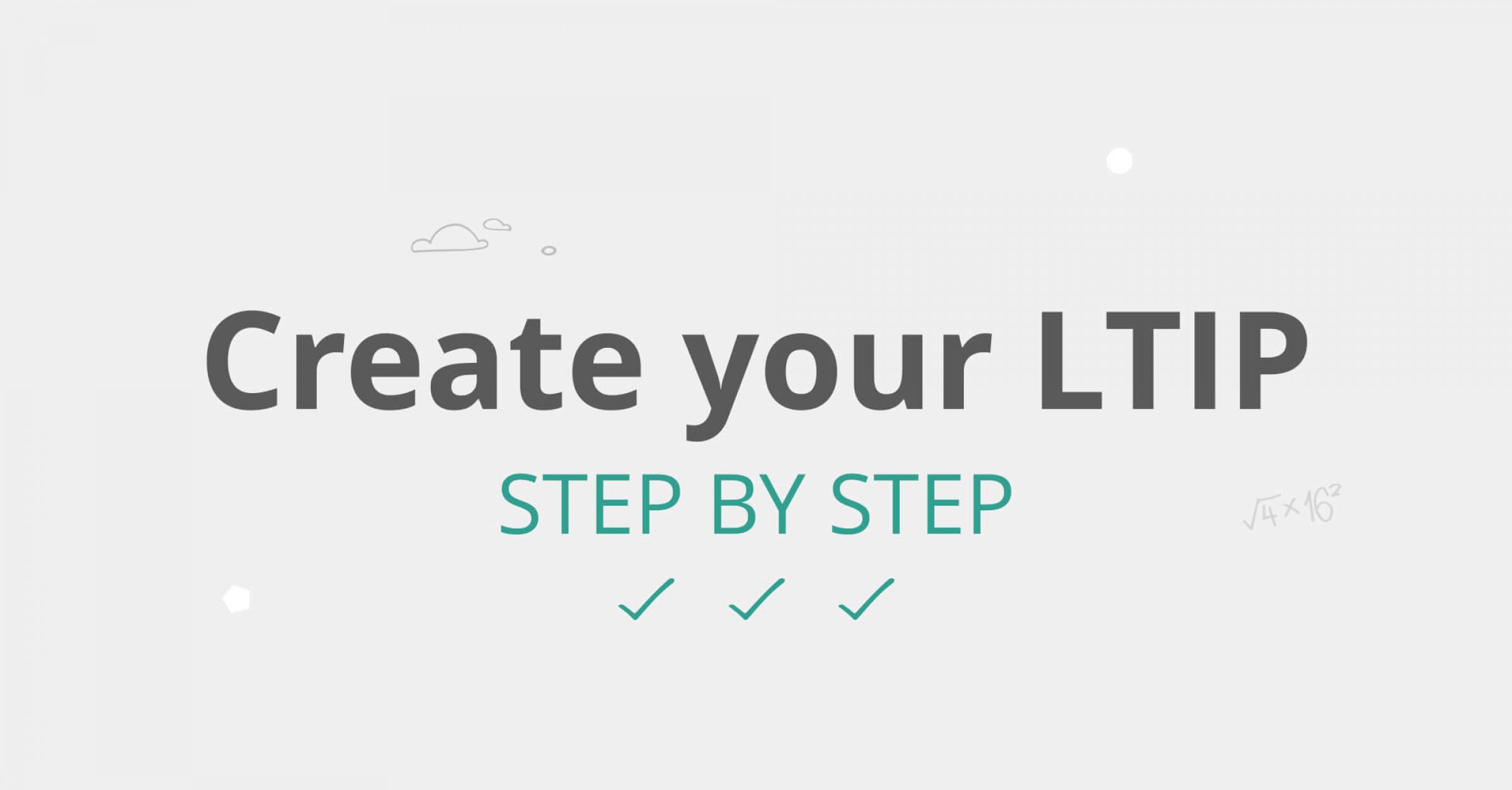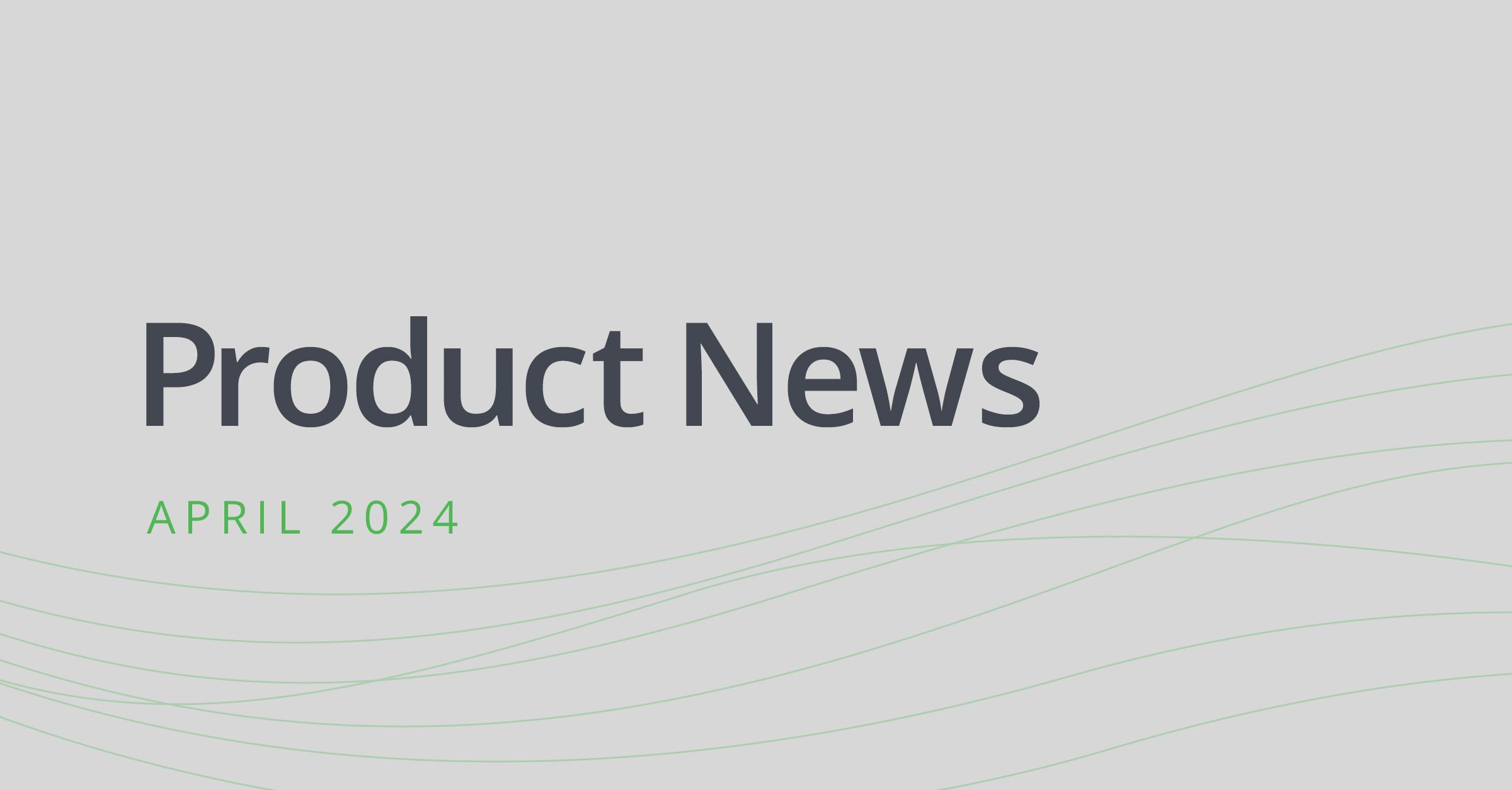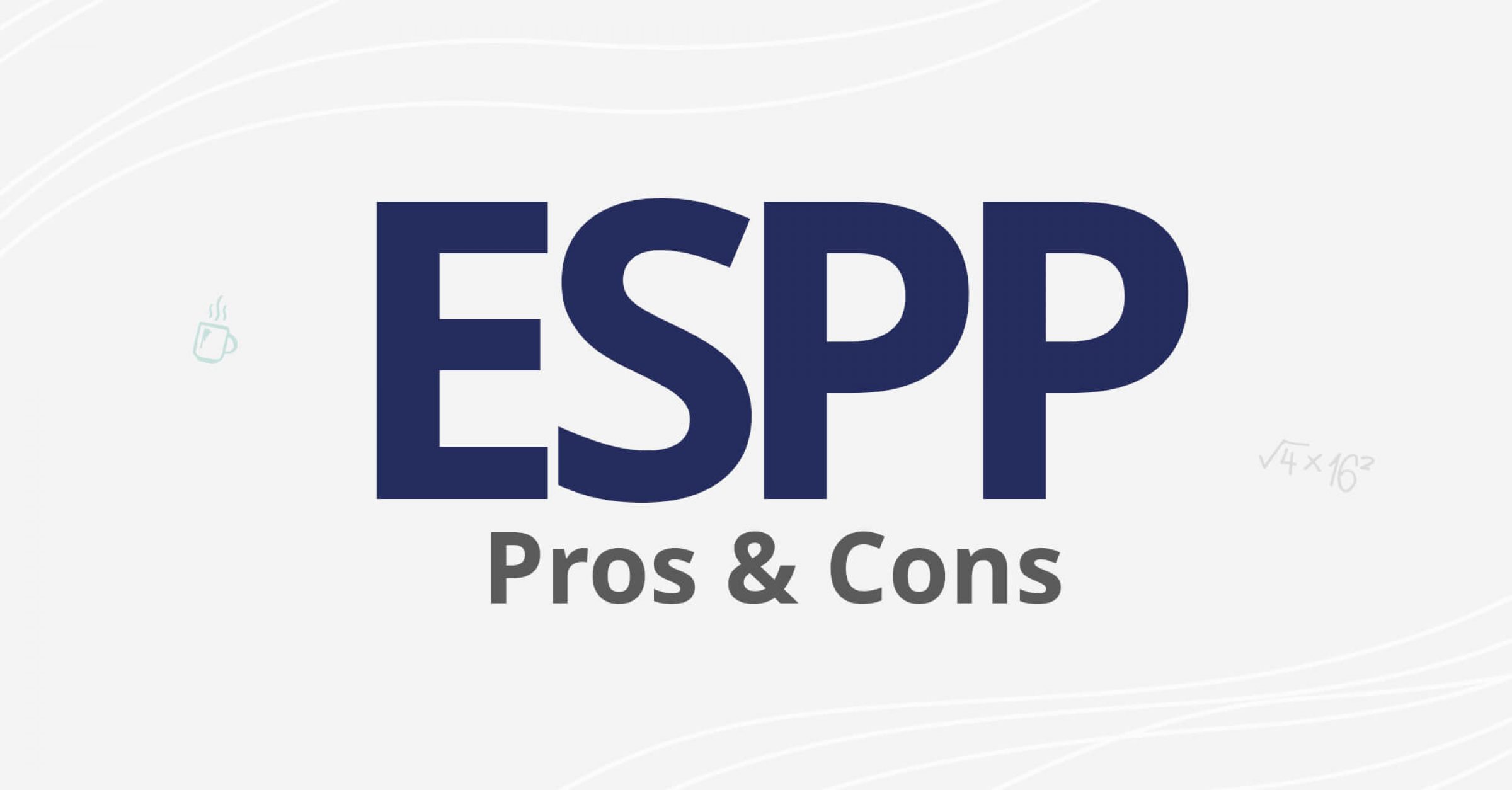Are you focused on how to get the best out of your employees and achieve your business objectives? If so, now may be the time for you to explore the possibilities around equity compensation in your workplace.
In the latest episode of Own Up, Chris Dohrmann is joined by guests Erin Fraser, VP of Business Development, Global Shares a J.P. Morgan company and Joanna Phillips, VP, ESOP Builders to take you through all you need to know about how employee ownership can help your company succeed and grow.
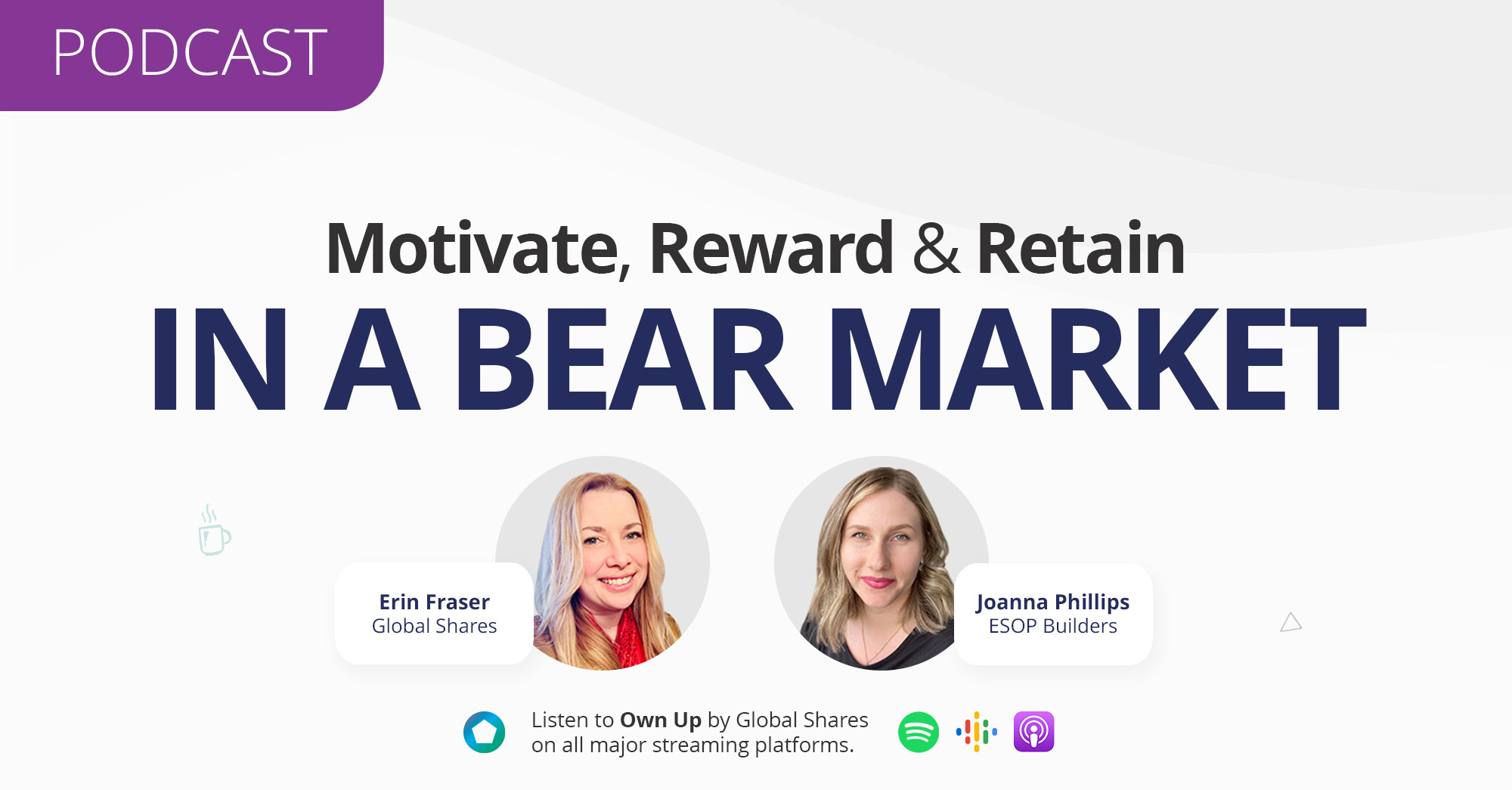
Ep17 Own Up Podcast: How to Motivate, Reward & Retain Employees in a Bear Market with Erin Fraser & Joanna Phillips
Read full transcript
00:00
This is Own Up, the Global Shares podcast about employee ownership and equity compensation. Answering questions and sharing with industry experts, here are your hosts, Chris Dohrmann and John Bagdonas.
Chris Dohrmann 00:21
Welcome back to Own Up, the Global Shares podcast all about employee ownership and equity compensation. I’m your host Chris Dohrmann. Today we are going to hear from two experts who believe in the power of employee share ownership plans. As we know attracting and retaining quality employees is becoming difficult in the ever-changing market. Employee Share Ownership Plans (ESOPs) are a fantastic way to engage and motivate your current employees while providing an attractive benefit to potential new employees. So let’s get straight to our podcast where our experts will explain the benefits of ESOPs along with the considerations for designing and implementing your own unique plans to keep your employees engaged and motivated. Let me hand it over to our VP of Business Development, Erin Fraser and VP at ESOP Builders, Joanna Phillips.
Erin Fraser 01:14
Thank you, everybody for joining us and the how to motivate, reward and retain in a bear market podcast. I’m here today with Joanna Phillips of ESOP Builders. We’re going to chat to you today about equity compensation, share ownership and how it works best for your company. If those of you don’t know me, my name is Erin Fraser, I work with Global Shares – a J.P. Morgan company. I’ve been in the equity compensation space for nearly 15 years now. I’ve seen everything from the company side to the vendor side. And I’m really happy to be here with you today. Thank you, Joanna, for joining us today. Tell us a bit about yourself.
Joanna Phillips 01:54
Hi, everyone. And hi Erin, thank you so much for having me. Super happy to be here. I am with ESOP Builders, and I’ve been with them for about four years now. My background is HR, Human Resources. So the employee ownership concept was a really great fit for what I was interested in, what I had studied and what my career ended up being. And so that’s why I’m here and happy to talk about employee ownership in the Canadian landscape as we go forward.
Erin Fraser 2:30
All companies have short and long term goals whether those include stock price targets, revenue or rate of return targets, expansion goals, the ability to weather the storm, etc. These cannot be accomplished without the best talent on board as we’re all aware. It’s important that we recognize our employees as our best asset who get us through hard times and help us identify the risks we should take to meet our goals and exceed our goals. As part of recognizing their importance, it’s imperative that we also reward them accordingly. We need to motivate and retain our employees and that’s why we’re here today to discuss employee ownership. Unfortunately, we are in a situation right now where market volatility and economic uncertainty are making it harder to push towards our goals. And depending on your industry, harder to attract, motivate and retain the employees that are key in driving your company to success.
According to HubSpot 2023 Marketing Strategy Report, 48% of global marketers say the potential for an economic downturn or recession has affected their company’s hiring plans in 2022. The recession has only exacerbated an existing issue. 35% of respondents say they had to slow down or pause their hiring efforts. 27% of respondents say their company had to fire or lay off employees and 26% of respondents say their company had to rescind offers made to prospective employees, which means you have to motivate your existing employees to perform at a higher capacity, making it that much more important to focus on retaining them. If you add in the impact of remote work throughout the pandemic, you have a situation where 54% of hiring experts in the last year have seen candidates turned down job offers when flexibility or remote working isn’t included in the agreement. So where you are fortunate to be able to hire in times like this, where you’re trying to move your existing employee base back to the office. If you can’t or don’t offer remote working or provide flexibility around remote working, you’ll need to offer an attractive compensation and benefits package in order to secure and retain talent.
So how do we attract, retain and motivate employees in a bear market? Well, you can offer flex days, free pizza and beer Fridays or a ping pong table in the lunchroom. But unless you put something tangible in front of your employees that reaps financial benefits as a reward for performance, you will not inspire the impact you’re looking for. What is a tangible reward? Well, it can be as simple as offering employees stock options or right to purchase company shares, giving them an opportunity to own some of the company they work for. That’s when we introduced the golden handcuffs. What are golden handcuffs you ask? Golden handcuffs are a collection of financial incentives that are intended to encourage employees to remain with a company for a stipulated period of time. They’re also intended to make your employees feel like owners by giving them a stake in the company. Now, some of you may ask, why would we do that? Well, as an example, if you give your employee a grant of 1000 shares, where they get 1/3 of that grant every year over three years, you not only motivate that employee to stay for the three year period, but you inspire better performance from that employee as well, because now they’re an owner. Share ownership breeds and cultivates a culture of innovation and promotes engagement. It’s just good for business.
In the Harvard Business Review, companies are more productive, grow faster and are less likely to go out of business than their counterparts with three things exist. One, at least 30% of the shares are owned by a broad based group of employees, two, all employees have access to ownership or the right to purchase shares in their company. And three, the concentration of ownership is limited, meaning it spread among a larger population. Why is this better for business, more people have skin in the game and something to lose if the business does not thrive. Employee ownership and the right to earn ownership, example, stock options, incentivizes employees to ensure the company does well because then they do well. Thus, employees who are productive and boost company earnings will benefit. But how do we make sure these golden handcuffs reap the most benefit for the company. By spreading the benefit of this ownership over multiple years, so employees can see the potential growth and their benefit, encouraging them to stay with the company and not leave to work for a competitor.
The Institute of Directors says that share plans create a more loyal and driven workforce. Employees who hold shares in their employer tend to work smarter, because they benefit directly from the growth of their company. This link between the factors of production of capital and labor is known as the wages of capital. In addition to increased productivity companies with share plans enjoy reduced absenteeism and better staff retention. Let me repeat myself, it’s good for business!
Joanna Phillips 7:20
Right. And as Erin was just starting to allude to, there’s obviously tons of different studies from the US that talk about the benefits of employee ownership and what that looks like. Unfortunately, in Canada, we just don’t have the same level of data available, especially for private companies. But there is still a lot of applicability from the information from the US that we’ll be using here. ESOPs in general can work for a wide variety of industries, for many different companies sizes as well, small, medium, large. And so it really doesn’t have to do specifically with a certain industry or with a certain company size. But you do want to identify what the right plan structure is going to be for your company. It’s not a one size fits all for sure. We can see from the studies that, you know, with the greater growth also comes great opportunity for new jobs.
Also, employee owners in successful ESOP companies are less likely to be laid off than non ESOP companies and non-employee owners. So really, how does this work? And we’ll get into more in more detail about that. But overall, ESOPs do generally have this long term mindset going on, right? So it’s the concept of long term retention, not only attraction and what’s going on in the immediate, in the present, but the focus on long term. If you are, you know, agreeing to come into a company and you’re agreeing to be part of that company, not only from an employee standpoint, but also from an ownership standpoint, you have these two levels of commitment rather than just the one. And so you’re more likely to stay for a longer period of time, you’re less likely to be tempted or to see, you know, grass is greener on the other side, you want to stay where you are, because you have this additional commitment that’s kind of pulling you to put your effort into the company that you’re at right now. Really, as a company, you’re retaining, but you’re also taking away the talent that you’re retaining from your competitors. So there’s sort of a double benefit.
Also, thinking about, you know, the cost and the effort that are involved in attracting and retaining because you have, you know, the training, the development of your people, you’re making the most of your benefit when implementing some sort of employee ownership plan to make sure that they’re happy where they are, and that your development of them, your training of them goes, the long haul. The other thing would be considering the alignment of the individual and your company goals. So it’s not only, you know, the individual has their own things that they’re pushing towards, the company has completely separate goals. Now you’re aligning those two things, because you have sort of their buy in, their commitment from that ownership standpoint, that they also want to get to that success, long term, increase company value, and increase their own portfolio share value, because they’re an owner as well.
And lastly, considering the retention rates and how that’s viewed for potential new employees, employees that are looking to your company as a possible place to work, they can see how long your group has been with the company, they can see how happy they are, they can see the results. And so they’re more likely to be attracted to your company. Now, this is where ESOP Builders comes into the picture. We are a firm specializing in design and implementation of employee share ownership plans. We’ve been around for over 25 years now. And not only do we consider sort of the ESOP from a technical standpoint, because of course, there’s the things of legal structure, tax considerations, business valuation, but we also want to consider how it’s being rolled out to the employees, how it’s being communicated. And also what the education component is like, as well. It’s, especially in Canada, employee ownership, not really being widely understood or even known about, we want to make sure that the potential participants understand the concept and understand what they’re going to be getting into. Now, I also want to add before we go further, that, in Canada, our concept of ESOP, the acronym, employee share ownership plan, different people might call that different things like employee stock option plan, or employee stock ownership plan. So we like to think of ESOP as employee share ownership plans, that is just describing the general concept of employee ownership, but it doesn’t necessarily describe the specific plan structure that you’re eventually going to implement.
When business owners come to us, and they’re interested in the concept. And you know, obviously, they’re starting to ask the questions, well, how do I start doing this? How do I design this for my company, we want them to first think about, what specifically are the goals that you’re wanting it to achieve. For today, of course, we’re talking about attraction and retention, there could be other goals that are in addition to those things, it could be part of an owner’s exit strategy or succession plan. Or it could be wanting to help the company and get to an IPO or a third party sale in the future. And so those are very different things. The goals that the owner wants to plan for, are going to drive how you strategically design and structure your plan. And so that’s why it’s really important to first identify those goals, and also identify how the ESOP can fit into your corporate structure. So from a tax and illegal perspective, especially in private companies, you really want to make sure that the ESOP will fit when you consider not only the company’s tax implications or legal implications, but also from the employee standpoint, you don’t want to put them into a negative position tax wise, if that could have been avoided at the outset of the program fairly easily. So that’s why first, we want to look at the corporate structure. And of course, there’s many methods to achieve employee ownership with the specific goal of attraction and retention.
Like I mentioned earlier, the owner’s goals that are in addition to that are going to help drive what your design of the plan looks like. And you might go more towards a stock option type of plan where the employee has the right to become an owner, the right to purchase shares in the future, and that incentivizes them to work towards improving the company’s success and proving the company’s value. Or you might have a direct purchase plan, an equity ownership plan, where the employees invest and become owners right away. And similarly, they have incentive to make the company more successful, to improve the company’s value and so on.
Overall, you want to make sure that it is attractive for their participation. Something that’s not going to be looked at favorably from the employees, they’re just going to decide, I’m not going to participate in that. So making sure that it does look attractive to join, that is easily accessible, especially if it’s a broad based program, where you want the majority of people to participate. Obviously, everyone is going to be at different positions in their career, in their life and their situations. So making it easily accessible through flexibility in share purchase, or flexibility in participation, depending on how your plan is structured is important. And that kind of brings me into, of course, getting into the details of the plan parameters, which we won’t go over today. But just wanting to note that these are important to consider, even if it’s something in the future, that is not going to be applicable right away. You still want to consider it and make sure that you’re defining it well. Things like the eligibility, how do you define that? How do people know if they can participate in this program or not? How do you allocate ownership to your employees? Is that going to be based on their position? Is it going to be just based on how much they make? Is it based on how long they’ve been with the company, lots of different things can be considered for that. And then into the future? You know, what if you do have someone that resigned after they’ve become an owner in the company, what if you have a termination that happens? So identifying what’s going to happen in those different situations that may occur in the future is going to be beneficial to you to have a successful program and not only, you know, from a legal standpoint, but also from a communication standpoint, making sure that when people see the program, see what you’re offering them, they know these different situations, and they know how it implicates them.
So we’ll just go over sort of things about what to avoid versus how to make sure your plan is successful. And there’s going to be, you know, some overlaps and things you’ll hear me say multiple times, which I think I would hope that that makes you think, Oh, this must be important. So complexity really is a big one, making sure that you keep it simple as much as you can. Of course, this program is not a simple plan. It’s not something that is going to avoid complexity. But throughout the implementation and design process, you should be able to kind of identify what areas are complex and simplify them. So that’s what we mean around avoiding complexity. Something that is implemented and stays complex is not well communicated. It’s not going to therefore be well understood. And the take up rate is not going to be great. Participation in your plan is one of those factors that shows you how successful it is. So having it simple and well understood is going to be a major indicator. If you haven’t first identified how it could fit into your corporate structure that could implicate how successful your plan is going to be moving forward. And also, not considering the communication to your employees, as I’ve mentioned before, launching the ESOP before even talking about the concept to your employees or before, you know, identifying why you wanted to do it in the first place as the business owner, those are really important as part of the rollout process and even ongoing to continue reiterating that when new employees are joining your company as well.
It’s easy to really focus on, you know, the benefits to the company, the downsides to the company, implications to the company. But we also want to think about the employee who is going to be participating, what are the rewards looking like for them, potentially, right, into the future, what could they be looking at? And we kind of break this down, you know, mainly it’s going to be the dividends or the share appreciation, or both, short term versus long term. And as I said before, most of the ESOPs that we work with, or that we help implement, are really focused on long term. But some companies do want to declare dividends, it’s always communicated that there’s never any guarantees, right? Like any investment there are risks.
And that it’s always up to the board to determine when dividends are going to be declared, if any. Ultimately, it’s up to the board as to how the profits of the company are going to be used. Mostly as long as it’s communicated well and the rollout has gone through smoothly. Employees coming into this program understand that, you know, it is a long term focus, and that they’re all aligned in their goals to improve company value, which improves their share appreciation. So they may not even want dividends, they may want to reinvest into the company that they’re a part of, that they’re a part owner in.
Tax advantages could be a big one for private company companies in particular, structuring it in a way that the employees can access, you know, the capital gains treatment rather than tax on income, and even access the lifetime capital gains exemption, where their gains might be tax free, will be a really big advantage for them, and could be a really nice incentive for them wanting to participate. But that’s one of the things when I was talking about earlier as looking at your corporate structure, making sure that the ESOP can fit into that to offer these tax advantages will be important. Something that’s simple to understand, and I’ve mentioned this before, clearly laid out that can be well integrated into other business strategies, like you’re going to be hiring people. And now you have this new program in place, how is that going to be communicated? So it does come down to branding. How are you branding your company to new potential employees, and how is the ESOP being integrated into that branding. And then finally, identifying what success means for your program, so that you can track it, you can measure it, and you can make sure that it is continually being successful for you long term.
Now, I mentioned, Canada doesn’t have a lot of data. The Toronto Stock Exchange did do a study, which I do like to highlight because it also shows all of the results that the US studies, and other studies in other parts of the world also show about successful ESOP companies, higher growth, higher profitability, higher productivity, and so on. And the National Center for employee ownership, they’re a US organization they have a lot of great data on ESOPs in the US with, you know, information on culture and behavioral aspects of ESOPs being applicable to the Canadian landscape as well. From an employee standpoint, there’s benefits there too, higher median household wealth, higher income from wages, higher retirement accounts, longer tenure in a company. So these are, of course, also really great benefits for the individual, not only just the company,
Erin Fraser 22:53
Thank you, Joanna, for that very informative set of information, I quite enjoy hearing about how best to structure plans. And I love statistics. So the statistics of that, the ESOP, and how it can really benefit a company and your employees is really important, I think, for us to point out here how important it is to have an ESOP in your company if you’re really looking to manage growth, and become that force within your industry.
We’re going to move on to the administration piece. So obviously, as we heard from Joanna, you know, there’s some complexities to the design of ESOP plans. But there’s also a bit of complexity, again, depending on how you really choose to structure it in terms of the administration of your plan as well. There’s probably 100 questions you could consider when trying to understand what you’re going to need around the administration of your plan, but some to consider would really be how much time would be required to manage the workload of the plan you’ve designed? And which portion of that workload would you be able to handle in house versus need to outsource? How many employees will be offered ownership? And do you want those employees to have visibility into their current and future ownership? What information do you want to track for effective reporting? Are there tax and compliance requirements, as touched on by Joanna.
Is your plan unique, requiring a significant manual workload? Or is it relatively standard? Meaning the workload isn’t as intense? How do you want to communicate the plan to your employees to promote a high level of engagement? Do you have those resources internally? Or again? Do you need to outsource to assist with the communication strategy that you’d like to deliver? And do you understand the financial reporting requirements of offering stock options and other awards? If you are, in fact, a reporting issuer? Those are just a few of the questions you could ask again, there are many, but ultimately it comes down to how best to answer these questions in a way that you meet the business objectives of offering a plan and create the best experience for your internal administration team and your employees. One important objective that I see with most companies is a high engagement rate of their employees. Keeping your employees engaged through their equity starts by giving them visibility into their awards.
Almost without question, the biggest challenge businesses deal with when it comes to equity compensation is clearly communicating their benefits. Often an employee will receive an email with some forms to fill in, and then they never see their options until a vesting day approaches. With a platform and employee access your employees can view and interact with their equity at any time and make it real in their minds. This helps build a culture of ownership and shows the employee their tangible assets within the company. Using a transparent digital platform is crucial for awareness and helps you encourage the correct behaviors when it comes to ownership of the company through consistent messaging and communication.
It’s also important to ramp up engagement around vesting days, the day your employees award becomes available to them. Companies need think about vesting dates in the same manner as a birthday, it’s something to be celebrated. They must engage with those employees particularly at the top level around vesting dates to ensure that the company remains central in the mind of the employee as they interact with their equity and celebrate the benefits of ownership. The most powerful engagement technique you have is one on one meetings, much like the communication of new grants using vesting days as an excuse to schedule individual performance review is an opportunity to ensure personal goals are aligned with business goals. You can also encourage your line managers or division leaders to promote the upcoming vesting dates and provide them with information on how, what, where, when and why of the vesting so they can keep their employees engaged and informed. Beyond these individual meetings, there are several options like interactive group workshops, sharing of past success stories, email nurture campaigns, town halls, where you explain what’s coming up with the vesting. What does it mean to them from a tax perspective, etc., just to keep them engaged and keep them really informed on why having ownership in the company is such a benefit.
That’s where we can help. As I mentioned previously, I work with Global Shares, a J.P. Morgan company, and we focus primarily on the administration of equity plans for all companies, automating your administration needs, no matter the size of your company, the industry, whether your private, private looking to go public or already public. I won’t go into too many details on it, as I know you’re here to learn. But if you do want to hear more, please reach out. And I’m happy to schedule a separate call on that. Okay, now we’re going to move to questions. The first one I see is actually for Joanna at ESOP Builders. The question is, do you see a trend with the types of plans companies are implementing as we go into a bear market?
Joanna Phillips 27:53
Great question! So it is interesting that I do see trends over the years as far as the types of specific structures that are used. Now, in small private companies, we’ve often seen plans be like equity ownership plans, where there is a purchase requirement, it’s usually every year, you know, there’s an annual offering, and the employees are allocated a certain amount, and they’re able to invest and purchase shares. And then the stock option concept we really saw very strictly for like the tech industry, startup companies like so it was more specific. But I think that’s being kind of incorporated more so recently, not just the equity ownership purchase plans, but also incorporating stock options as part of that, or instead of that, not just for startups, not just for tech, but in other industries and for more established companies. So it is kind of interesting to see that changing a bit. Ultimately, every company is different. There’s never been one two plans that are exactly the same.
Erin Fraser 29:07
Wonderful, thank you for that. There’s another question here for you as well. And it’s just asking if there’s a specific company type that would be ideal for launching an ESOP.
Joanna Phillips 29:20
Again, there’s different considerations that would kind of make me answer a certain way. So and in terms of going through, you know, the full sort of holistic process that ESOP Builders does, which is a two stage process, we first go into identify if it’s feasible, and then we help you design and implement. Going through that process it really depends on having an established company already a company that’s been around for at least two years, and has at least 10 employees. But that’s not to say a company that’s newer or has less employees can’t do to employee ownership, you can still do that. So really, you know, I consider it if you have, like more than two people in your company, you can have an employee ownership plan, it’s just always going to come down to the goals of what you as the owner are looking to achieve.
Erin Fraser 30:17
Well, that about does it for us today. If you have any more questions, please do submit them through, we’re happy to respond and have a conversation with you as well, depending on the complexity of the questions. And I just wanted to thank Joanna again for joining us here today. It’s very insightful, the information you reviewed with us. And I hope that everyone who joined did get some something of value out of today’s session in terms of one, when choosing whether to offer an employee ownership plan internally, and two, if you already are, how best to kind of drive it towards internal corporate objectives. Joanna, do you have anything to say before we wrap up?
Joanna Phillips 30:55
Well just thank you as well, Erin, it was a pleasure. And I’m happy to be here. Happy to have further conversation as needed, if anyone has any questions.
Erin Fraser 31:06
Wonderful. Thank you everyone for joining and we hope you have a fantastic day. Bye for now!
Chris Dohrmann 31:11
That was Erin Fraser, our Global Shares VP of Business Development speaking with Joanna Phillips, Vice President at ESOP Builders. For contact or more information for Joanna or Erin, just check the show notes in the description area of this podcast.
Thanks for listening to this episode of Own-Up by Global Shares. If you like what we are doing, why not share with friends or leave a review! If you like what we’re doing, why not share with friends or leave a review. Until next time, take care!
The Own Up podcast is brought to you by GlobalShares.com. To get the inside track on employee ownership and equity compensation, click ‘Follow’ on your podcast player right now so you get the next episode automatically. Information provided in this podcast is intended for informational and educational purposes only. It may contain views which differ from the views of JPMorgan Chase and Co. For specific guidance on how this information should be applied to your situation, you should consult a qualified professional. For full details see the show notes on your podcast player right now. The Own Up podcast is produced by dustpod.io for globalshares.com
Information provided in this podcast is intended for informational and educational purposes only. Guests on the Own Up podcast may not be affiliated with JP Morgan Chase & Co. The podcast contains the views of a JP Morgan employee, which may differ from the views of JP Morgan Chase & Co., its affiliates and employees. The views and strategies described may not be appropriate for everyone. Certain information was obtained from sources we believe are reliable, but we cannot verify the accuracy of the content and we accept no responsibility for any direct or consequential losses arising from its use. You should carefully consider your needs and objectives before making any decisions. For specific guidance on how this information should be applied to your situation, you should consult a qualified professional.
Please Note: This publication contains general information only and Global Shares is not, through this article, issuing any advice, be it legal, financial, tax-related, business-related, professional or other. The Global Shares Academy is not a substitute for professional advice and should not be used as such. Global Shares does not assume any liability for reliance on the information provided herein.




